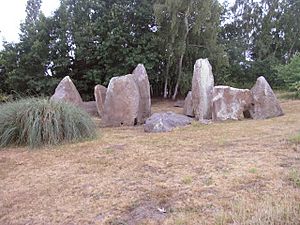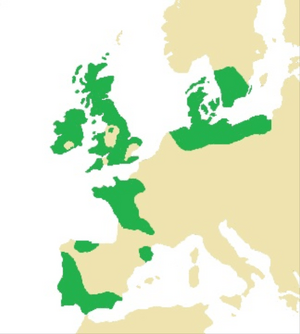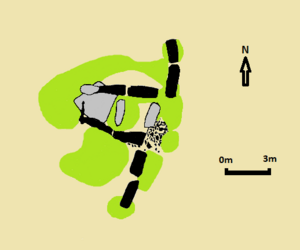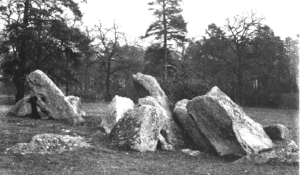Chestnuts Long Barrow facts for kids

The sarsen megaliths that were once part of the chamber of the long barrow
|
|
| Lua error in Module:Location_map at line 420: attempt to index field 'wikibase' (a nil value). | |
| Location | Addington, Kent |
|---|---|
| Type | Long barrow |
| Owner | Rose Alba |
Chestnuts Long Barrow, also known as Stony Warren or Long Warren, is an ancient burial mound near Addington in Kent, England. It was likely built around 4500-3800 BC, during Britain's Early Neolithic period. Today, it is mostly in ruins, but it still tells us a lot about people who lived thousands of years ago.
Archaeologists have found that these long mounds were built by early farming communities. These groups had just started growing crops and raising animals in Britain. Chestnuts Long Barrow is part of a special group of monuments called the Medway Megaliths. These are found near the River Medway in Kent. Chestnuts Long Barrow is close to Addington Long Barrow and Coldrum Long Barrow. Other similar sites, like Kit's Coty House, are on the other side of the river.
The long barrow was built where people had lived even earlier, during the Mesolithic period. It was a long, rectangular mound of earth, about 50 feet (15 meters) long. Inside, it had a chamber made from huge stones called sarsen megaliths. People placed human remains in this chamber during the Neolithic period. They also left pottery pieces, stone arrowheads, and a clay pendant. Later, around 400 AD, a Romano-British hut was built nearby. In the 12th or 13th century, the chamber was badly damaged, possibly by people looking for treasure or by Christians who wanted to destroy old pagan sites. Over time, the earth mound disappeared, leaving only the stone chamber ruins. People have been interested in these ruins for centuries, and archaeologists excavated the site in 1957. The site is on private land today.
Contents
What is Chestnuts Long Barrow?
Chestnuts Long Barrow is a protected ancient monument. It sits on a hillside on private land. The monument gets its name from Chestnuts Wood, which is nearby. Before the mid-1900s, it was known as Stony Warren or Long Warren. The barrow is about 100 feet (30 meters) above sea level. It is built on soft sandstone covered with white sand.
Why were these monuments built?
The Early Neolithic period was a time of big change in Britain. Between 4500 and 3800 BC, people started farming instead of hunting and gathering food. This change came from contact with people in Europe. Kent was an important place for these new ideas to arrive because it is close to Europe and the River Thames.
Britain was mostly covered in forests back then. People probably raised cattle and moved around a lot. They didn't build many permanent homes.
What are the Medway Megaliths?
In the Early Neolithic, people in Western Europe started building huge structures. Many of these were "chambered long barrows." These were long mounds of earth with a stone or wooden chamber inside. These chambers often served as tombs for the dead. People were usually buried together in these tombs, not alone. This way of building tombs spread from Europe to Britain.
The Medway Megaliths were some of the largest burial monuments in Britain. They are found along the River Medway in Kent. They are the only group of large stone monuments in eastern England. The Medway Megaliths are divided into two groups: one to the west of the river and one to the east. Chestnuts Long Barrow is in the western group, along with Coldrum Long Barrow and Addington Long Barrow. The eastern group includes Kit's Coty House and Little Kit's Coty House.
All the Medway long barrows share a similar design. They are all aligned from east to west. Each had a stone chamber at the eastern end of the mound. They were quite tall inside, up to 10 feet (3 meters) high. The chambers were built from sarsen stones. These are strong, hard stones found naturally in Kent. Builders would have moved these huge stones to the site.
These shared features show that the builders in the Medway area had a strong local style. However, each monument also had unique features. For example, Coldrum is more rectangular, and Chestnuts Long Barrow had a special front design. Archaeologists think these differences might be because the tombs were changed over time.
Archaeologists are not sure exactly where the idea for these monuments came from. Some think it was from nearby European countries, while others suggest Ireland or Brittany. But everyone agrees that the Medway Megaliths are part of a bigger tradition of building large tombs across Early Neolithic Europe.
How was Chestnuts Long Barrow built?
Archaeologists found evidence of older human activity beneath the monument. They found many flint tools from the Mesolithic period. This suggests that people lived on this spot for a long time before the barrow was built.
Chestnuts Long Barrow was built very close to Addington Long Barrow. The chamber was made from sarsen stones found nearby. These stones were arranged to form two "trilithons" (two upright stones with a third stone across the top). These formed the roof of the chamber. The chamber was shaped like a trapezoid, about 12 feet (3.6 meters) long, 7.5 feet (2.3 meters) wide, and probably 10 feet (3 meters) high. It faced mostly east to west, possibly towards the Medway Valley. The entrance was likely blocked by a large stone.
One idea is that the earth mound was built first. It might have been used as a ramp to drag the huge stones into place. The builders might have filled the chamber with sand to hold the stones up. Once the roof stones were in place, they would have removed the sand. In 1950, people thought there were 14 stones left, but excavations found 18 large sarsen stones and four smaller ones.
The chamber had a stone floor where human remains were placed. Archaeologists found about 3,500 pieces of bone, from at least nine or ten people, including one child. Some bodies were buried whole, while others were cremated (burned). Early bones were found with pottery from the Windmill Hill culture. It's unusual to find cremated bones from this period, so it might have been very important.
Along with the human remains, archaeologists found items like 34 pieces of pottery, three stone arrowheads, and a clay pendant. These were probably buried with the dead. In the area in front of the tomb, they found 100 pieces of pottery from at least eight bowls. These might have been moved from inside the chamber to make room for more burials.
Even though the earth mound was gone by the 1950s, its old name "Long Warren" suggests people remembered it. Excavations found parts of the mound's edges. It was probably trapezoid-shaped, about 60 feet (18 meters) wide. Its length might have been about 50 feet (15 meters).
What happened later?
Archaeologists found pottery from the British Iron Age and many pieces of Roman pottery, mostly from the 4th century AD. A hut from the 4th century was also found next to the barrow. This hut was likely a field shelter, not a home.
During the Middle Ages (11th to 13th centuries), the tomb was heavily damaged. Medieval pottery was found in the pits made by those who destroyed it. The destruction was done very carefully. First, the earth mound around the chamber was dug away. Then, an entrance was forced into the chamber. The chamber was cleared out, and the stones were pushed over. It seems this damage was not done to get building stones or to clear land for farming.
Some archaeologists think the damage was from treasure hunters. Others believe it was done by Christians trying to destroy old pagan sites. The way the stones were broken and buried suggests a deliberate act of destruction.
Archaeologists also found signs of modern activity. People used the site for picnics, and it was known as a rabbit warren. Finds from this period include clay pipes, marbles, bricks, and bottles.
What stories are told about the stones?
In 1946, a local story was recorded about the Medway Megaliths. People believed it was impossible to count the number of stones correctly. This kind of story is common at other ancient stone sites in Britain and Ireland. It suggests that people thought these huge stones had a life of their own.
How have people studied the barrow?
People have been interested in Chestnuts Long Barrow since the 1700s. Early writers described it as an "ancient British temple." In the 1840s, Reverend Beale Post studied the Medway Megaliths, including Chestnuts Long Barrow.
In the late 1940s, archaeologists John H. Evans and Albert Egges van Giffen visited the site. In 1953, it was noted that trees and bushes were growing among the stones. The landowner, Richard Boyle, found Mesolithic flint tools while digging test trenches.
In the late 1950s, with plans to build a house nearby, the government decided to excavate the site. John Alexander led the excavation in 1957. It lasted five weeks and was funded by the landowner and supported by the Inspectorate of Ancient Monuments. Volunteers helped with the digging. After the excavation, the fallen stones were put back into their original places, restoring part of the chamber. The items found during the excavation are now kept at Maidstone Museum.






